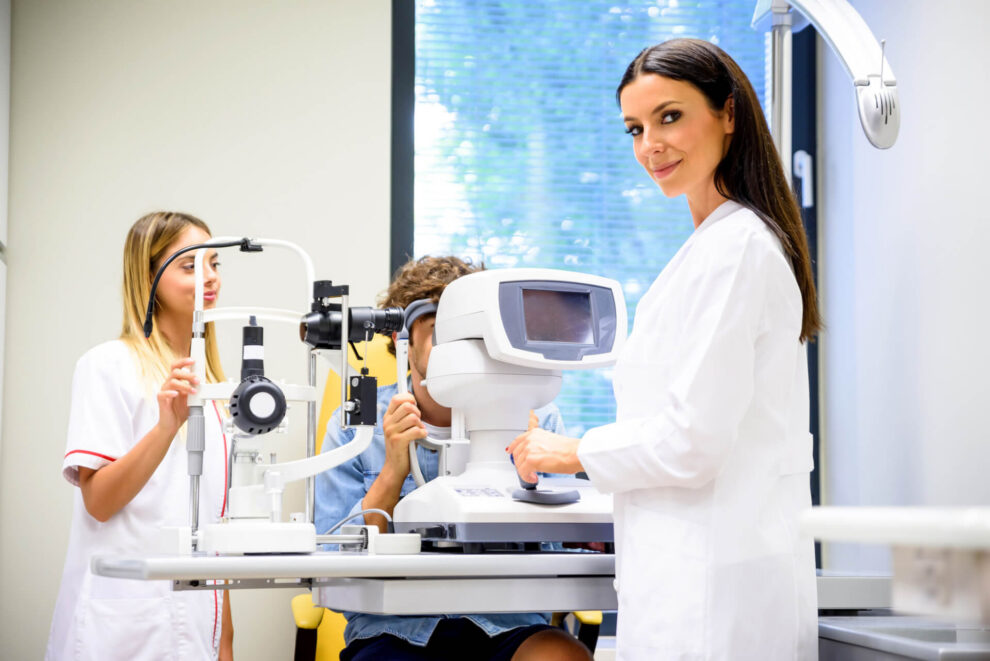Posted by: Kentucky Eye Institute in Specialty Care

The eyeball is one of the quickest-healing organs in the human body, with most minor scratches and irritations healing on their own in about two days. However, if you have red, itchy, gritty, or watery eyes that just don’t seem to heal, you might be suffering from one of several ocular surface diseases. While most of them won’t permanently damage your eyesight, they can be painful and unpleasant.
Read on to learn more about these diseases and how to find treatment for them.
Types of Ocular Surface Diseases
Ocular surface diseases are a group of diseases that impact the surface of your eye, primarily the cornea, conjunctiva, eyelids, and surrounding glands. Ocular surface disease symptoms include:
- dry eyes
- itchy or irritated eyes
- feeling like there’s something in your eye
- redness in or around the eye
- pain
- blurred vision
- excessively watery eyes
These symptoms can become chronic, and occasionally the nerves around the eye will stop sending pain signals, even though the condition persists. This is why it is important for you to get treatment as soon as you notice symptoms.
Several conditions can trigger these symptoms, some of them quite common. All of them should be treated by an eye doctor as soon as possible.
Dry Eye Syndrome
The most common ocular surface disease is dry eye syndrome. It’s exactly what it sounds like–your eyes are too dry. Our eyes stay moist using our tears, mucus, and oil from glands along the eyelid called meibomian glands.
Meibomian glands secrete their oil to keep the tears from drying out. Meibomian gland dysfunction occurs when the glands don’t produce enough oil or the oil is crusty and dry. Without the oil, your tears dry up, leaving the eye dry and easily irritated.
Dry eye syndrome can also occur when your body doesn’t produce enough tears. While this is sometimes the result of another medical condition or even aging, your environment can also impact your ability to produce tears.
Extended screen viewing and dry, windy environments can contribute to or even cause dry eye syndrome. Changing your environment can help alleviate the symptoms, but dry eye syndrome can also become chronic.
Conjunctivitis
Conjunctivitis is more commonly known as pink eye because it turns affected eyes pink or reddish. This condition occurs when the conjunctiva in the eye swells and is inflamed.
The conjunctiva is the lining of the eyelid and the whites of the eye. Bacteria, viruses, and allergies can all cause swelling and irritation in the conjunctiva.
Pink eye from bacteria and viruses can be very contagious. If you suspect you have pink eye, you should stay home and consult with a doctor remotely. For mild cases, you can treat your symptoms at home.
Blepharitis
Blepharitis is an ocular surface disease of the eyelids. It is usually caused by blockages in the oil glands at the base of the eyelashes. People suffering from blepharitis will have swollen, red eyelids that can cause discomfort.
While this condition isn’t contagious and won’t damage your eyesight, it is painful and requires treatment. Blepharitis can lead to chronic pink eye or more serious infections around the eyes.
Chemical and Thermal Burns
Not all ocular surface diseases come from dysfunction in the eyes. External forces and injuries can damage these organs and cause irritation. Two common sources of irritation are chemical and thermal burns.
Chemicals in common household substances like cleaning solutions, fertilizers, nail polish removers, car batteries, or plasters can burn your eyes. When you get substances like these in your eye, you should wash out your eyes immediately and then seek treatment.
Unlike other ocular surface diseases, burns are an injury, not a chronic condition. These injuries should be treated as soon as possible, as the damage can be severe and irreversible.
Ocular Surface Disease Treatments
Treatments for ocular surface diseases range from symptom management to, in rare cases, surgical intervention. For many ocular surface diseases, the treatment goal is to stop the condition before it causes a more serious illness or injury.
Even if your eye irritation seems mild, it’s a good idea to see an eye doctor to rule out any serious conditions. A good eye doctor can even make recommendations for the best over-the-counter products to treat mild conditions.
Over-the-Counter Medications
Ocular surface diseases like pink eye and blepharitis can usually be treated with over-the-counter medications and home remedies. Warm eye compresses or artificial tears can help wash out irritants and keep the eye area germ-free.
If you wear contact lenses, it’s a good idea to use your glasses instead for the duration of your treatment. Most over-the-counter eye drops are not compatible with contacts and can increase irritation rather than helping!
Prescription Medications
When over-the-counter medications aren’t helping your symptoms, or if there is a more serious infection on your eye, your eye doctor may give you prescription medications.
Prescription antibiotics for ocular surface conditions come in a variety of forms. There are ointments and creams for external application and medicated eyedrops that you apply directly to the surface of your eyeball.
Surgical Procedures
In rare cases, ocular surface diseases need more serious treatments. Damage from chemical and thermal burns can be severe enough that the organs on the surface of the eye need to be replaced.
Less serious surgeries include placing plugs in the tear ducts called punctal plugs. These plugs prevent tears from draining away from your eyes, increasing the amount of moisture there. Plugs can be temporary or more long-lasting, depending on your specific eye condition.
Find Relief
If you’re experiencing any of these symptoms, you should see an eye doctor as soon as possible. They will work with you to get a diagnosis and start a treatment plan.
Come visit us in Lexington or at any of our locations across Kentucky to get relief for your ocular surface diseases today.
